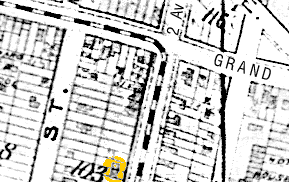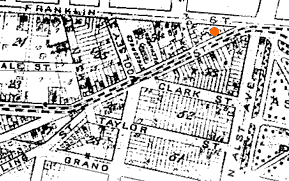 FLANAGAN FAMILY IN ASTORIA, QUEENS
FLANAGAN FAMILY IN ASTORIA, QUEENS
Biographical Sketch - Andrew FLANAGAN, Sr. - part 3
Part 1 |
Part 2 |
Part 3 |
Sarah A. (Matthews) Flanagan
|
1850
Astoria Election (Brooklyn Eagle, May 9, 1850, Pg. 2)
The election for Charter officers was held on Tuesday in Astoria, when the
following gentlemen were chosen nearly unanimously:
Trustees--Arthur Donnelly, William Kelly, Stephen A. Halsey,
Nathaniel Filby, Eezekiah Booth.
Village Clerk--Edwin Mills
Collector--Andrew Flanagan
Treasurer--Henry F. Blackwell
Constable--William Green
|
The year 1850 saw the onset of profound change in the Flanagans' lives.
Andrew, aged about 45, was elected to village office,
and a series of real estate transactions suggest that
he was preparing for a mid-life change of career and circumstances.
I know nothing substantial about his public service, aside
from the fact that he was elected "collector" of the village of Astoria in 1850
(see item on right),
and in 1852 was listed as "treasurer" of an Astoria
"Mutual Benevolent Association."
The Flanagans purchased two new properties, one on 2nd Avenue that
became known to their descendants as "the old homestead,"
and the other a commercial site which was to provide
Andrew with a change in occupation.
They also supplemented or refinanced (I'm not sure which) the Woolsey Street property
they had owned since 1836.
I suspect the family was in transit during 1850, since they were absent from the
1850 federal census.
|
 ca. 1890 map.
ca. 1890 map.
 The intersection of Grand and Second Avenue.
The gold dot marks my guess as to the location of Andrew and Sarah's house.
Click to see extension of map.
The intersection of Grand and Second Avenue.
The gold dot marks my guess as to the location of Andrew and Sarah's house.
Click to see extension of map.
Below is an 1963 photo of what descendants called "the Old Homestead".
|
1850 LAND PURCHASES
1. Feb 5, 1850 (recorded Dec 9) For $440, Andrew bought 8 lots (672 to 679)
on 2nd Avenue, 300 feet south of Grand, from Henry L. Riker. This was the land
on which the family was to settle and which
was broken up to provide a land share for some of their children.
The house built on this land was later known as the "Old Homestead"
and by legend was known as the birthplace of all of Andrew and Sarah's children.
Unless they rented this property prior to purchase, I believe this is untrue
and the children born after John and before Charles were born in
the Flanagan's first house on Woolsey Street.
This ca 1890 Sanborn Insurance Map shows
1st and 2nd Avenue and what I believe are the 8 lots, and their eventual distribution
to family members. Andrew Jr. and Charles both lived on property (#536 and 506)
that belonged to their in-laws. (Prints on legal sized paper).
2. Sep 2, 1850 (recorded Sep 10), for $2,125 Andrew &
Sarah Flanagan purchased from Edwin Hoyt and Astoria merchant,
4 lots, #1,2,3,4, in Hallets Cove, belonging to Robert Anderson.
Andrew borrowed $500 from Thos B. Jackson May 7, 1850, (Mortgage Liber 56 p306).
A puzzling aspect of this transaction is that lots 1-4 were said to be the parcels of land
on Woolsey Street that they had purchased from Anderson in 1836 and 1841,
and on which we assume the family lived between 1836 and 1850.
This suggests to me that these 1850 transactions were part of a more
complex series of land transfers that I have not yet uncovered.
 ca. 1890 map. The orange dot is my best guess as to location of the land north of
Main was located. The site of Andrew Flanagan's grocery store. (Click to see extension of map.)
ca. 1890 map. The orange dot is my best guess as to location of the land north of
Main was located. The site of Andrew Flanagan's grocery store. (Click to see extension of map.)
|
3. Drafted Sep 25, 1850, (filed Oct 2, Lot 56).
For $1,850, Andrew Flanagan purchased from Henry L. Riker the "property north of Main Street".
This was the land on which Andrew's grocery store would be located.
It was said to be 133'6" E. of Willow St, and only two other dimensions are mentioned:
23' 3" and 20'.
Willow (north/south) is 18th St. today. Owen became Franklin St. and is now 27th Ave. (which runs into Astoria Blvd.) Main Street is still Main.
As far as I know, these plots were the last lands purchased by Andrew himself.
I have not done an extensive search of the grantor libers to see how many of these plots he sold,
or the mortgage libers to see how they were financed.
|
Jun 19, 1851 saw the birth of Andrew and Sarah's last son, my great grandfather Charles.
The next year was also a significant one for the Flanagans.
The child William, age 8, died on or about Jul 23, 1852 in an accident involving a falling embankment.
The death was the occasion of the appropriation of a family plot in the churchyard of
St. Mary's (later known as Our Lady of Mt. Carmel).
In 1852, when he traveled from Astoria to Chambers Street in Manhattan
to open his Emigrant bank account,
Andrew Flanagan would have ridden a ferry over to 92nd Street in Manhattan,
a stagecoach from 86th Street down to 42nd Street,
and the 3rd Avenue horse trolley downtown.
The
Greater Astoria Historical Society
recounts the memories of someone who made such a commute.
|
A few months after William's death, on Nov 3, 1852,
Andrew Flanagan and John Small, an Irish immigrant gardener in the neighboring village of Ravenswood,
opened a business account at Emigrant Industrial Savings Bank on Chambers Street in Manhattan.
The organization they represented was called the Astoria "Mutual Benevolent Association,"
and Andrew was treasurer and John chairman.
I have found no clues about the nature of this organization
but I suspect it was a burial fund, used to pay interment costs for impoverished
parishioners of St. Mary's.
On Jun 6, 1856, Andrew opened a second account at Emigrant Savings Bank,
this one a personal savings account.
Upon his death, this account was transferred to Amelia and Sarah.
See page on the Emigrant Savings Bank for
the information contained in the personal identification section of these bank records.
Aside from naming his home townland in Ireland (unreadable), the 1856 account gave the information that
Andrew still considered himself a mason by occupation.
However, four years later, at the age of 55, he was finally listed as a grocer.
On Jul 18, 1860, the Flanagan family was caught by the federal census taker.
This census gave no addresses, and the first Astoria city directory was not
compiled until 1864 but it was probably at the new home on 2nd Ave.
(r# 843 pg. 733, Newtown, Queens, NY)
Andrew (55) was now a grocer, with real estate holdings worth $2300 and a personal estate of $300.
The older boys James (24), John (21), Andrew (19) and Henry (16) were all listed as masons.
Catharine (20) was a tailoress and Bridget (18) a seamstress
The younger boys Peter (14), Edward (12) and Charles (9) were in school.
(Catherine's inclusion on her parents' census was dubious, as she was also enumerated in Brooklyn
with her new husband, Edmund Butler and infant son Edmund, Andrew's first grandchild).
The 1860s were comparatively uneventful for Andrew, at least in terms of public records.
He settled in as a grocer and watched his older children marry.
In 1863, James married Bridget Delahanty, in 1865, Andrew married Adelaide Exertier, and
Bridgett Amelia married Welsh immigrant George Morgan Jones.
(As far as I can tell, none of the Flanagan boys fought in the Civil War.)
The first Astoria city directories appeared in 1864, and Andrew's listing
as a grocer at "Main n. Junc. Franklin" appeared in every issue.
His home address was 2nd av & Grand.
(See transcription of
Boyd's 1864 directory of Astoria)
|
DEATH
Andrew's death on Friday February 25, 1870 preceded the compilation of
death registers in Long Island City, so we will probably never know the cause of his death.
Note that his (gravestone transcription) cites February 28, 1870,
which was actually his date of burial.
His death was tersely noted in Manhattan's New York Herald, a paper
widely read by Irish immigrants, and that carried informative obituaries,
Sometimes naming Irish parishes and townlands.
Death Notice, Andrew Flanagan, (Manhattan: New York Herald, Feb 26-27, 1870),
call NC 567 - box 19; Lamont Library, Harvard.)
N.Y. Herald - Saturday February 26, 1870, page 7
FLANAGAN--On Friday, February 25, ANDREW FLANAGAN, aged 66 years.
The friends of the deceased are respectfully invited to attend the funeral, on Sunday afternoon,
at three o'clock, from his late residence, Second avenue, Astoria.
|
At the time of his death, Andrew had only six grandchildren
(Pauline E. and Charles E. Flanagan; Edmund, Charles, and Harry Butler; and Ella (Jones) Charlton).
But his last grandchild, Stella (Flanagan) Ferguson, born in 1895 to his youngest son Charles,
would bring the count to 55.
The Jun 14, 1870 federal census leaves a snapshot of the family as Andrew left it.
(No addresses listed, Astoria, Newtown, Queens, reel# 1080, page 157)
Sarah (age 65) was head of household, with real estate valued at $8,000 and a personal estate of $400.
Still living with Sarah were her unmarried children John (28 [sic]), Henry (23), Peter (22), Edward (21) and Charles (18).
John, Henry and Edward were brickmasons. Peter and Charles were listed as painter and carpenter.
Henry, Peter and Charles were not yet settled into the occupations in which
they spent the remainder of their lives.
John, who would die the next year at age 33, might have been listed twice, once with his mother and
once as a grocer, living next to a LALOR family, who lived on Willow and Main,
and who who may have been related to Peter Flanagan's wife-to-be.
James (35) and Bridget (Delahanty) were living on the opposite side of the Lalor family, with real estate
worth $500 and personal estate of $200.
Living two houses after James was the Thomas Kelly family, whose daughter Catherine would marry
Edward Flanagan.
Andrew Jr. was listed as an engine builder with real estate of $8000 and personal $100.
He was married with three children, aged 3 years to 1 month.
Catherine Butler was living with her career Army Captain husband in Wallace Co., KS.
They had three boys aged 3 - 10.
Amelia was living with her husband George Morgan Jones and two daughters, age 4 and 1,
at 367 3rd Avenue in Manhattan.
|
|